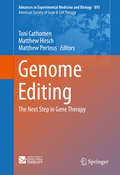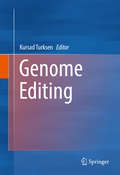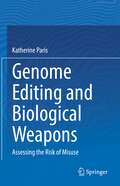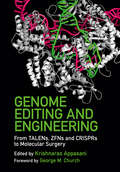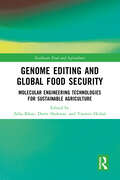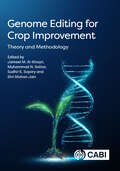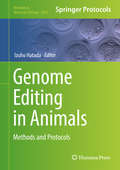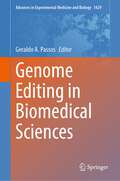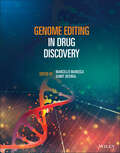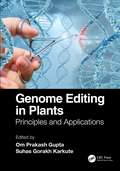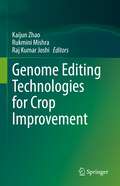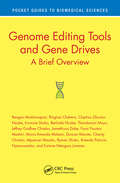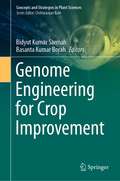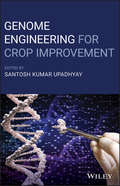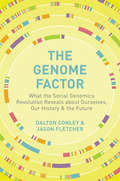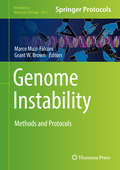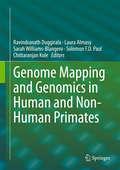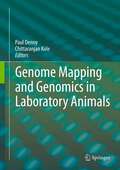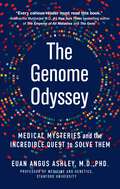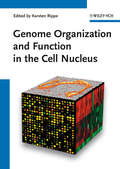- Table View
- List View
Genome Duplication
by Melvin DePamphilis Stephen D. BellGenome Duplication provides a comprehensive and readable overview of the underlying principles that govern genome duplication in all forms of life, from the simplest cell to the most complex multicellular organism.?Using examples from the three domains of life - bacteria, archaea, and eukarya - Genome Duplication shows how all living organisms store their genome as DNA and how they all use the same evolutionary-conserved mechanism to duplicate it: semi-conservative DNA replication by the replication fork. The text shows how the replication fork determines where organisms begin genome duplication, how they produce a complete copy of their genome each time a cell divides, and how they link genome duplication to cell division.?Genome Duplication explains how mistakes in genome duplication are associated with genetic disorders and cancer, and how understanding genome duplication, its regulation, and how the mechanisms differ between different forms of life, is critical to the understanding and treatment of human disease.
Genome Editing
by Toni Cathomen Matthew Hirsch Matthew PorteusThis comprehensive volume explores human genetic engineering its pre-clinical and clinical applications, current developments, and as treatment for hereditary diseases. It presents and evaluates the most recent advances in the understanding of mammalian host DNA repair mechanisms, such as double-strand break induced gene targeting and mutagenesis, the development of zinc-finger nucleases, genome editing for neuromuscular diseases, phase integrases, triplex forming oligonucleotides and peptide nucleic acids, aptamer-guided gene targeting, AAV gene editing via DSB repair, engineered nucleases and trinucleotide repeat diseases, and creation of HIV-resistant cells. The expertly authored chapters contextualize current developments within the history of genome editing while also discussing the current and potential safety concerns of this rapidly growing field. Genome Editing: The Next Step in Gene Therapy, the latest volume in the American Society of Gene and Cell Therapy series, deftly illuminates the potential of genetic engineering technology to eradicate today's deadliest and most prolific diseases. It is ideal reading for clinicians and researchers in genetics and immunology.
Genome Editing
by Kursad TurksenThis timely volume explores the use of CRISPR-Cas9 for genome editing, presenting cutting-edge techniques and their applications in treatment of disease. The chapters describe latest methods such as use of targetable nucleases, investigation of the non-coding genome, mouse genome editing, increasing of knock-in efficiency in mouse zygotes, and generation of reporter stem cells; the text contextualizes these methods in treatment of cardiovascular disease, diabetes mellitus, retinitis pigmentosa, and others. The final chapters round out the book with a discussion of controversies and future directions. Genome Editing is an essential, of-the-moment contribution to this rapidly growing field. Drawing from a wealth of international perspectives, it presents novel techniques and applications for the engineering of the human genome. This book is essential reading for all clinicians and researchers in stem cells, regenerative medicine, genomics, biochemical and biomedical engineering- especially those interested in learning more about genome editing and applying it in a targeted, specific way.
Genome Editing: Current Technology Advances and Applications for Crop Improvement
by Shabir Hussain Wani Goetz HenselOver the last few decades, various techniques have been developed to alter the properties of plants and animals. While the targeted transfer of recombinant DNA into crop plants remains a valuable tool to achieve a desirable breeding outcome, integration of transgenes into the host genome has been random, which in part, leads to reduced acceptance of GMOs by the general population in some parts of the world. Likewise, methods of induced mutagenesis, such as TILLING, have the disadvantage that many mutations are induced per plant, which has to be removed again by expensive backcrossing. Advances in genome sequencing have provided more and more information on differences between susceptible and resistant varieties, which can now be directly targeted and modified using CRISPR/Cas9 technology. By selecting specific gRNAs occurrence of off-target modifications are comparatively low. ZFNs and TALENs- based approaches required re-engineering a new set of assembled polypeptides for every new target site for each experiment. The difficulty in cloning and protein engineering prevented these tools from being broadly adopted by the scientific community. Compared to these technologies, designing the CRISPR toolbox is much simpler and more flexible. CRISPR/Cas9 is versatile, less expensive and highly efficient. It has become the most widely used technology for genome editing in many organisms.Since its inception as a powerful genome-editing tool in late 2012, this breakthrough technology has completely changed how science is performed. The first few chapters in this book introduce the basic concept, design and implementation of CRISPR/Cas9 for different plant systems. They are followed by in-depth discussions on the legal and bio-safety issues accompanying commercialization and patenting of this emerging technology. Lastly, this book covers emerging areas of new tools and potential applications. We believe readers, novice and expert alike, will benefit from this all-in-one resource on genome editing for crop improvement.Chapter 17 is available open access under a Creative Commons Attribution 4.0 International License via link.springer.com.
Genome Editing and Biological Weapons: Assessing the Risk of Misuse
by Katherine ParisThis monograph introduces current genome editing technologies—clustered regularly interspaced short palindromic repeat (CRISPR)-CRISPR-associated (Cas) systems, transcription activator-like effector nucleases (TALENs), and zinc-finger nucleases (ZFNs)—and provides an assessment of the risk of misuse of these technologies based on the following parameters: accessibility, ease of misuse, magnitude of potential harm, and imminence of potential misuse. The findings from this assessment are applied to analyze and evaluate the threat posed by the intentional misuse of genome editing technologies to develop biological weapons. Furthermore, the book discusses the implications of misuse for different applications of genome editing, such as making existing pathogens more dangerous, modifying the human microbiome, weaponizing gene drives, engineering super soldiers, and augmenting the general population to confer economic advantages. Technologies that enable genome editing with programmable nucleases—including CRISPR, TALEN, and ZFN—allow for the precise genetic modification of organisms and cultured cells. While these technologies are used for a variety of beneficial applications, intelligence and defense experts have raised concerns that genome editing technologies, especially CRISPR, could be misused to develop new and improved biological weapons. Furthermore, experts worry that the number and type of actors who could potentially misuse genome editing is dramatically increasing given the democratization of biology, which is allowing biology to become more accessible to everyone including nonexperts. The book provides a comprehensive assessment of how feasible it is for users with different levels of knowledge and skill to acquire and then to apply the technologies to develop a biological weapon. It also provides an assessment of governability and a tailored set of recommendations that address security concerns. These recommendations are sensitive to the cost-benefit trade-off of regulating genome editing technologies. The book targets researchers as well as intelligence analysts, defense and security personnel, and policymakers.
Genome Editing and Engineering: From TALENs, ZFNs and CRISPRs to Molecular Surgery
by Krishnarao AppasaniRecent advances in genome editing tools using endonucleases such as TALENs, ZFNs, and CRISPRs, combined with genomic engineering technologies, have opened up a wide range of opportunities from applications in the basic sciences and disease biology research, to the potential for clinical applications and the development of new diagnostic tools. This complete guide to endonuclease-based genomic engineering gives readers a thorough understanding of this rapidly expanding field. Chapters cover the discovery, basic science, and application of these techniques, focusing particularly on their potential relevance to the treatment of cancer, and cardiovascular and immunological disease. The final section discusses the legal and ethical issues which accompany the technology. Providing authoritative coverage of the potential that genome editing and engineering have, this is an ideal reference for researchers and graduate students and those working in the biotechnology and pharmaceutical industries, as well as in a clinical setting.
Genome Editing and Global Food Security: Molecular Engineering Technologies for Sustainable Agriculture (Earthscan Food and Agriculture)
by Zeba Khan Durre Shahwar Yasmin HeikalWith the rapid increase in the global population and changing climatic impacts on agriculture, this book demonstrates how genome editing will be an indispensable technique to overcome ongoing and prospective agricultural challenges. This book examines the role of genome editing in improving crop yields and contributing to global food security. It summarizes a range of genome editing techniques and discusses the roles they can play in producing a new generation of high-yielding, climate-ready crops. This includes site-specific nucleases, precision genome engineering, clustered regularly interspaced short palindromic repeats, and bioinformatics. It showcases how these gene editing techniques can tailor plants to not only increase yield-related traits but to also make them better suited to their environment and to be resistant to pests and extreme climatic events, such as droughts. The book also examines genome editing regulations and policies, the commercialization of genome-edited crops, and biosafety and biosecurity concerns. Overall, this book reveals and showcases how genome editing can improve crop resilience and production to address current and future agricultural challenges and alleviation of global food security concerns. This book will be of great interest to students and scholars of agricultural science, crop and plant science, genome editing, sustainable agriculture, biotechnology, and food security.
Genome Editing for Crop Improvement: Theory and Methodology
by Shri Mohan Jain Jameel M. Al-Khayri Muhammad N. Sattar Sudhir K. SoporyGenome editing offers a powerful tool to significantly accelerate crop-breeding programs in order to develop new and improved varieties. It allows precise modification of an organism's DNA sequence, often by creating targeted double-strand breaks at specific locations. The CRISPR-Cas system has emerged as the preferred method of gene editing and offers a powerful technology for crop improvement. The use of CRISPR in plant research has led to significant improvements in crop performance in terms of yield, nutrition, stress tolerance and resistance against agricultural pests and diseases. This book explores the cutting-edge field of genome editing, its applications and potential to revolutionize the genetic improvement of crops. It includes: Foundational concepts and historical context of genome editing (GE). Structure and mechanisms of various genome editing techniques. Application of GE for trait improvements in plants. Regulatory, biosafety, and ethical considerations. This is a valuable resource for researchers in crop genetic improvement, graduate and postgraduate students in molecular biology and biotechnology programs, and professionals in the field.
Genome Editing in Animals
by Izuho HatadaThis volume details protocols that can be used for generation of knockout animals. Chapters guide the reader through basic protocols for three genome editing technologies, target design tools, and specific protocols for each animal. Written in the highly successful Methods in Molecular Biology series format, chapters include introductions to their respective topics, lists of the necessary materials and reagents, step-by-step, readily reproducible laboratory protocols, and tips on troubleshooting and avoiding known pitfalls. Authoritative and practical, Genome Editing in Animals: Methods and Protocols aims to ensure successful results in the further study of this vital field.
Genome Editing in Animals: Methods and Protocols (Methods in Molecular Biology #2637)
by Izuho HatadaThis second edition provides new and updated protocols that can be used for generation of knockout animals. Chapters guide the reader through basic protocols for three genome editing technologies, target design tools, and specific protocols for each animal. Written in the successful Methods in Molecular Biology series format, chapters include introductions to their respective topics, lists of the necessary materials and reagents, step-by-step, readily reproducible protocols, and notes on troubleshooting and avoiding known pitfalls. Authoritative and cutting-edge, Genome Editing in Animals: Methods and Protocols, Second Edition aims to be a useful practical guide to researches to help further their study in this field.
Genome Editing in Biomedical Sciences (Advances in Experimental Medicine and Biology #1429)
by Geraldo A. PassosThis volume focuses on applying the Crispr system in editing the genome of human cells (in vitro and in vivo) and model organisms used in biomedical research. With the advent of Crispr technology, genome editing soon became a procedure of great interest to laboratories worldwide due to its relative ease and accuracy. In biomedical sciences, genome editing by Crispr has already enabled the development of new experimental model systems. In medicine, therapeutic alternatives for the genetic "correction" of diseases have already begun to appear. Therefore, the book's purpose is to bring in a single volume, chapters that show the scientific community in biomedicine, medicine, human genetics, oncology, virology, and parasitology, among others, the advances in genomic editing. In a chapter dedicated to the ethical aspects of human genomic editing, we also address what we can and should do with this (bio)technology. The book chapters were written by productive researchers specializing in Crispr genome editing. The chapters cover the concept of Crispr and genome editing and how to use this new methodology in biomedical research and medicine, among other aspects, including the ethical controversy around its use in humans. The writing of the chapters keeps a specialized language intelligible enough for those who want to introduce themselves to the subject.
Genome Editing in Cardiovascular and Metabolic Diseases (Advances in Experimental Medicine and Biology #1396)
by Junjie XiaoThis book provides the latest research progress on genome editing in cardiovascular and metabolic diseases and includes bioinformatics research methodology of genome editing. Genome editing is a genetic engineering technique precisely modified specific target genes of organism genome, which has been applied to basic theoretical research and production applications from plants and animals to gene therapy of human beings. Cardiovascular and metabolic diseases have become major factors affecting human health worldwide. This book contains information about bioinformatics, genome editing in cardiovascular diseases, genome editing in metabolic diseases and therapeutic effects. It will be useful for biologist, cardiologist, cardiovascular surgeons, endocrinologist, internists, nurses, undergraduate and graduate students in medicine and cell biology and others interested in cardiovascular and metabolic medicine.
Genome Editing in Drug Discovery
by Marcello Maresca Sumit DeswalGENOME EDITING IN DRUG DISCOVERY A practical guide for researchers and professionals applying genome editing techniques to drug discovery In Genome Editing in Drug Discovery, a team of distinguished biologists delivers a comprehensive exploration of genome editing in the drug discovery process, with coverage of the technology’s history, current issues and techniques, and future perspectives and research directions. The book discusses techniques for disease modeling, target identification with CRISPR, safety studies, therapeutic editing, and intellectual property issues. The safety and efficacy of drugs and new target discovery, as well as next-generation therapeutics are also presented. Offering practical suggestions for practitioners and academicians involved in drug discovery, Genome Editing in Drug Discovery is a fulsome treatment of a technology that has become part of nearly every early step in the drug discovery pipeline. Selected contributions also include: A thorough introduction to the applications of CRISPRi and CRISPRa in drug discovery Comprehensive explorations of genome-editing applications in stem cell engineering and regenerative medicine Practical discussions of the safety aspects of genome editing with respect to immunogenicity and the specificity of CRISPR-Cas9 gene editing In-depth examinations of critical socio-economic and bioethical challenges in the CRISPR-Cas9 patent landscape Perfect for academic researchers and professionals in the biotech and pharmaceutical industries, Genome Editing in Drug Discovery will also earn a place in the libraries of medicinal chemists, biochemists, and molecular biologists.
Genome Editing in Plants: Principles and Applications
by Om Prakash Gupta, Suhas Gorakh KarkuteGenome Editing in Plants: Principles and Applications addresses the information of genome editing starting from principles and historical aspects to the latest advancements in the field. As genome-editing technology has emerged as promising and cutting edge, researchers around the world have started producing original research outputs, which have significantly improved our current understanding and potential of this technology. The initial chapters of this book describe different genome-editing tools as well as their principles and applications. Other chapters are dedicated to the present status and future applications of genome-editing techniques in various crop improvement programmes. Some of the advanced applications of CRISPR/Cas tools, such as base editing and RNA detection, along with regulatory aspects of genome-edited crops are described in detail. This book serves as a valuable resource to researchers in the field of crop improvement; graduate and postgraduate students engaged in plant molecular biology and biotechnology; academicians; and policy makers. Key Features: Addresses topics associated with historical development and principles of genome-editing technology Addresses basic mechanisms operating under each genome-editing technology Addresses its application in plants to design crops as per the current and future demands Addresses the regulatory mechanisms of genome-edited crops
Genome Editing Technologies for Crop Improvement
by Kaijun Zhao Rukmini Mishra Raj Kumar JoshiThis book compiles the relevant information related to genome editing tools and their roles in crop improvement. The book contains a brief introduction about various genome editing tools and their application in major crops. It discusses the genome editing approaches and the strategies used for genome editing in different crops. Some of the chapters cover the detailed methodology of sgRNA design, vector construction and transformation in different crops followed by data analysis. A few chapters focus on the applications of genome editing tools towards crop improvement. This book will be of particular interest to plant biologists working in the field of genome editing and crop breeders. It will provide valuable information and useful material for our readers’ experimental work.
Genome Editing Tools and Gene Drives: A Brief Overview (Pocket Guides to Biomedical Sciences)
by Reagan Mudziwapasi Ringisai Chekera Clophas Zibusiso Ncube Irvonnie Shoko Berlinda Ncube Thandanani Moyo Jeffrey Godfrey Chimbo Jemethious Dube Farai Faustos Mashiri Moira Amanda Mubani Duncan Maruta Charity Chimbo Mpumuzi Masuku Ryman Shoko Rutendo Patricia Nyamusamba Fortune Ntengwa JomaneGenome-editing methods are becoming routine tools for molecular and cell biologists. Such tools include ZFNs, CRISPR, megaTALs and TALENs. These tools are revolutionizing the creation of precisely manipulated genomes to modify the characteristics of organisms or cells. Additionally, gene drives have altered the way we understand inheritance laws. They give us the ability to have total control of the inheritance of traits of choice and importance. This succinct volume summarizes the history, principles and applications – as well as the advantages and disadvantages – of each of these tools and various kinds of gene drives. The book is part of a program to produce books helpful to students and faculties of science at colleges and universities. This volume in the Pocket Guides to Biomedical Sciences series will help demystify these technologies. The book fills the gap between established conventional methods and the novel and exciting newly introduced tools of genome editing and gene drives. It will help young scientists understand the emerging genome-editing tools and gene drives, thereby promoting related research and adoption. Key Features Extensively reviews the current genome-editing tools and gene drives Clarifies the targeting mechanisms and specificity of genome-editing tools Details many different types of natural and synthetic gene drives Highlights concerns with gene drives and genome-editing tools Related Titles Brown, T. A. Genomes 4 (ISBN 978-0-8153-4508-4) Samuelsson, T. The Human Genome in Health and Disease: A Story in Four Letters (ISBN 978-0-8153-4591-6) Soh, J., et al. Genome Annotation (ISBN 978-1-4398-4117-4)
Genome Engineering for Crop Improvement (Concepts and Strategies in Plant Sciences)
by Bidyut Kumar Sarmah Basanta Kumar BorahThis book serves the teachers, researchers and the students as a handy and concise reference as well as guidebook while designing and planning for use of the advanced technologies for crop improvement.The content of the book is designed to cover the latest genome engineering techniques for crop improvement. The conventional breeding has got its limitations such as non-availability of desired genes within the genepool. In many cases, breeding has been highly used and it has nearly reached its highest limit so far as the productivity and production of crops are concerned. However, with increasing need of food and decreasing resources, including water, land, labour, etc., to feed the growing population, the alternative available ways of increasing crop productivity need to be explored and exploited. Genome engineering has a wide scope that includes technologies such as genetic engineering and transgenesis, RNA technologies, CRISPR, cisgenics and subgenics for better productivity and more efficient biotic and abiotic stress management. Therefore, the book is planned to enlighten the readers with the advanced technologies with examples and case studies, whenever possible. Efforts will be made to emphasize on general efforts on various major food crops; however, it would also be made clear that such efforts could be taken as proofs of concepts and that this could be extrapolated keeping the demand in mind.
Genome Engineering for Crop Improvement
by Santosh Kumar UpadhyayIn recent years, significant advancements have been made in the management of nutritional deficiency using genome engineering—enriching the nutritional properties of agricultural and horticultural crop plants such as wheat, rice, potatoes, grapes, and bananas. To meet the demands of the rapidly growing world population, researchers are developing a range of new genome engineering tools and strategies, from increasing the nutraceuticals in cereals and fruits, to decreasing the anti-nutrients in crop plants to improve the bioavailability of minerals and vitamins. Genome Engineering for Crop Improvement provides an up-to-date view of the use of genome editing for crop bio-fortification, improved bioavailability of minerals and nutrients, and enhanced hypo-allergenicity and hypo-immunogenicity. This volume examines a diversity of important topics including mineral and nutrient localization, metabolic engineering of carotenoids and flavonoids, genome engineering of zero calorie potatoes and allergen-free grains, engineering for stress resistance in crop plants, and more. Helping readers deepen their knowledge of the application of genome engineering in crop improvement, this book: Presents genetic engineering methods for developing edible oil crops, mineral translocation in grains, increased flavonoids in tomatoes, and cereals with enriched iron bioavailability Describes current genome engineering methods and the distribution of nutritional and mineral composition in important crop plants Offers perspectives on emerging technologies and the future of genome engineering in agriculture Genome Engineering for Crop Improvement is an essential resource for academics, scientists, researchers, agriculturalists, and students of plant molecular biology, system biology, plant biotechnology, and functional genomics.
The Genome Factor: What the Social Genomics Revolution Reveals about Ourselves, Our History, and the Future
by Jason Fletcher Dalton ConleyFor a century, social scientists have avoided genetics like the plague. But the nature-nurture wars are over. In the past decade, a small but intrepid group of economists, political scientists, and sociologists have harnessed the genomics revolution to paint a more complete picture of human social life than ever before. The Genome Factor describes the latest astonishing discoveries being made at the scientific frontier where genomics and the social sciences intersect.The Genome Factor reveals that there are real genetic differences by racial ancestry—but ones that don't conform to what we call black, white, or Latino. Genes explain a significant share of who gets ahead in society and who does not, but instead of giving rise to a genotocracy, genes often act as engines of mobility that counter social disadvantage. An increasing number of us are marrying partners with similar education levels as ourselves, but genetically speaking, humans are mixing it up more than ever before with respect to mating and reproduction. These are just a few of the many findings presented in this illuminating and entertaining book, which also tackles controversial topics such as genetically personalized education and the future of reproduction in a world where more and more of us are taking advantage of cheap genotyping services like 23andMe to find out what our genes may hold in store for ourselves and our children.The Genome Factor shows how genomics is transforming the social sciences—and how social scientists are integrating both nature and nurture into a unified, comprehensive understanding of human behavior at both the individual and society-wide levels.
Genome Generation
by Elizabeth FinkelThe year 2001 marked more than just the beginning of Stanley Kubrick's Space Odyssey, it marked the beginning of the genome era. That was the year scientists first read the 3 billion letters of DNA that make up the human genome. This was followed by a veritable Noah's Ark of genomes—sponges and worms, dogs and cows, rice and wheat, chimps and elephants—180 creatures aboard so far. So what have we learned from all this? How has it changed the way we practise medicine, grow crops and breed livestock? What have we learned about evolution? These are the questions science writer and molecular biologist Elizabeth Finkel asked herself four years ago. To find the answers she travelled the science frontier from Botswana to Boston, from Warracknabeal to Mexico and tracked down scientists working in the field. Their stories, told here, paint the picture of what it means to be part of the genome generation. 'The Genome Generation is absolutely riveting. These tales from the frontier are a 'must read' for everyone who wishes to understand our past—the logic of evolution—or take a peep into our exciting future at the creation of 'super plants' through 'digital agriculture'.'—R.A. Mashelkar, CSIR Bhatnagar Fellow and India President, Global Research Alliance
Genome Instability
by Marco Muzi-Falconi Grant W BrownThis volume presents forty-two methods and protocols to analyze diverse aspects of genome instability. Chapters detail mutagenesis and repair, methods to quantify and analyze the properties of DNA double-strand breaks, profile replication, replication proteins strand-specifically, genome instability, fluorescence microscopic techniques, and genomic and proteomic approaches. Written in the highly successful Methods in Molecular Biology series format, chapters include introductions to their respective topics, lists of the necessary materials and reagents, step-by-step, readily reproducible laboratory protocols, and tips on troubleshooting and avoiding known pitfalls. Authoritative and cutting-edge, Genome Instability: Methods and Protocols aims to provide a comprehensive resource for the discovery and analysis of the proteins and pathways that are critical for stable maintenance of the genome.
Genome Mapping and Genomics in Human and Non-Human Primates
by Ravindranath Duggirala Laura Almasy Sarah Williams-Blangero Solomon F.D. Paul Chittaranjan KoleThis book provides an introduction to the latest gene mapping techniques and their applications in biomedical research and evolutionary biology. It especially highlights the advances made in large-scale genomic sequencing. Results of studies that illustrate how the new approaches have improved our understanding of the genetic basis of complex phenotypes including multifactorial diseases (e. g. , cardiovascular disease, type 2 diabetes, and obesity), anatomic characteristics (e. g. , the craniofacial complex), and neurological and behavioral phenotypes (e. g. , human brain structure and nonhuman primate behavior) are presented. Topics covered include linkage and association methods, gene expression, copy number variation, next-generation sequencing, comparative genomics, population structure, and a discussion of the Human Genome Project. Further included are discussions of the use of statistical genetic and genetic epidemiologic techniques to decipher the genetic architecture of normal and disease-related complex phenotypes using data from both humans and non-human primates.
Genome Mapping and Genomics in Laboratory Animals
by Chittaranjan Kole Paul DennyMapping of animal genomes has generated huge databases and several new concepts and strategies, which are useful to elucidate origin, evolution and phylogeny. Genetic and physical maps of genomes further provide precise details on chromosomal location, function, expression and regulation of academically and economically important genes. The series Genome Mapping and Genomics in Animals provides comprehensive and up-to-date reviews on genomic research on a large variety of selected animal systems, contributed by leading scientists from around the world. Laboratory animals are those species that by accident of evolution, domestication and selective breeding are amenable to maintenance and study in a laboratory environment. Many of these species are studied as 'models' for the biology and pathology of humans. Laboratory animals included in this volume are sea-urchin, nematode worm, fruit fly, sea squirts, puffer fishes, medaka fish, African clawed frog, mouse and rat.
The Genome Odyssey: Medical Mysteries and the Incredible Quest to Solve Them
by Dr. Euan Angus AshleyIn The Genome Odyssey, Dr. Euan Ashley, Stanford professor of medicine and genetics, brings the breakthroughs of precision medicine to vivid life through the real diagnostic journeys of his patients and the tireless efforts of his fellow doctors and scientists as they hunt to prevent, predict, and beat disease.Since the Human Genome Project was completed in 2003, the price of genome sequencing has dropped at a staggering rate. It’s as if the price of a Ferrari went from $350,000 to a mere forty cents. Through breakthroughs made by Dr. Ashley’s team at Stanford and other dedicated groups around the world, analyzing the human genome has decreased from a heroic multibillion dollar effort to a single clinical test costing less than $1,000. For the first time we have within our grasp the ability to predict our genetic future, to diagnose and prevent disease before it begins, and to decode what it really means to be human.In The Genome Odyssey, Dr. Ashley details the medicine behind genome sequencing with clarity and accessibility. More than that, with passion for his subject and compassion for his patients, he introduces readers to the dynamic group of researchers and doctor detectives who hunt for answers, and to the pioneering patients who open up their lives to the medical community during their search for diagnoses and cures. He describes how he led the team that was the first to analyze and interpret a complete human genome, how they broke genome speed records to diagnose and treat a newborn baby girl whose heart stopped five times on the first day of her life, and how they found a boy with tumors growing inside his heart and traced the cause to a missing piece of his genome.These patients inspire Dr. Ashley and his team as they work to expand the boundaries of our medical capabilities and to envision a future where genome sequencing is available for all, where medicine can be tailored to treat specific diseases and to decode pathogens like viruses at the genomic level, and where our medical system as we know it has been completely revolutionized.
Genome Organization And Function In The Cell Nucleus
by Karsten RippeBy way of its clear and logical structure, as well as abundant highresolution illustrations, this is a systematic survey of the players and pathways that control genome function in the mammalian cell nucleus. As such, this handbook and reference ties together recently gained knowledge from a variety of scientific disciplines and approaches, dissecting all major genomic events: transcription, replication, repair, recombination and chromosome segregation. A special emphasis is put on transcriptional control, including genome-wide interactions and non-coding RNAs, chromatin structure, epigenetics and nuclear organization. With its focus on fundamental mechanisms and the associated biomolecules, this will remain essential reading for years to come.

